
Wine Culture and Information since 2002 - Volume 22
 Wine Culture and Information since 2002 - Volume 22 |
|
Exercises for Sensorial TastingThe practice of sensorial and organoleptic tasting of wine requires experience and continuous training, a patient task indispensable for improving the taster's capacities |
|
The sensorial and organoleptic tasting of wines is a practice requiring lots of commitment, concentration and a continuous training, and just like in many other activities, the knowledge of theoretics notions just represents a fundamental factor. The knowledge of theory and of the techniques of tasting is certainly useful and represents a valid tool and a starting point in order to plan a good strategy in the sensorial evaluation. However the practice of tasting requires lots of experience and will, last but not the least, the capacity of being curious as well as having a good attitude to investigation by means of one's own senses. These capacities can be improved and increased thanks to a continuous training done with a constructive and comparative strategy. Tasting the highest possible number of wines is fundamental, moreover tasting wines from many producers, different areas, different grapes, different qualities, allows the taster to acquire experience by means of a pretty vast knowledge. After all, wine cannot be understood just by reading it on books: what improves the skill of a taster is what has been poured on his or her glass and that was “read” by his or her senses, and most important, the taster knows the wine because he or she is able to recognize it.
|
|
A good tasting session can be recognized by the way it was organized and, first of all, by the intended goal of the event. Not all the tasting sessions offer the right occasions for improving the taster's capacities: sometimes the evaluation of wine is done, both for practical reasons and for professional needs, in conditions which are not favorable for educational purposes. However it is possible to organize specific tastings with the purpose of improving our capacities and our experience while ensuring the right concentration, attention and method in order to get good educational results. The essential condition which allows the achievement of this result is, first of all, the availability of a tranquil room with no disturbing elements where the sensorial tasting of wine can be done in a profitable way. The experience of the taster is based on many factors and on the many educational opportunities he or she can take into advantage in order to improve culture and experience, sad to admit, never enough, always and however improvable. By considering the practice of tasting affects the emotional and sensorial aspect of the one who is doing it, as well as considering that every wine makes an unique experience to be added to all the previous ones, a fundamental role is played by the capacity of remembering every experience. These experiences will be useful in future tastings and will help to better compare and recognize. On this regard it is certainly useful and advisable to have at hand, during the tasting sessions, tools which allow to take note of the many aspects of the sensorial tasting, such as sheet of papers or a computer.
Taking notes of the tastings is an extremely useful practice provided they are properly organized and classified: they will make an important studying tool and they will represent a precious “historical memory” of all experiences. The operation of taking time for writing notes on a sheet of paper, or on a specific computer application, about the impressions and evaluations of a wine helps, as a matter of fact, to consciously think about the characteristics found. For this purpose the many wine tasting associations have realized proper forms which allow the taster to take note of the sensorial evaluations in a profitable and organized way. In case it is not possible to have specific forms for taking notes about sensorial evaluations, it will be enough to make use of a normal sheet of paper where the taster will write all the impressions and all the characteristics found during the tasting. It will be good to divide the sheet in specific sections where in every one of them will be written considerations about appearance, olfactory and gustatory evaluations, as well as general considerations about the wine. For example, it will be taken note of the color and of transparency, of the nature of aromas and of their quality, including the description of aromas found in a wine, body, intensity of flavors and balance, finally, a personal opinion and judgment of the wine based on the many phases of the tasting. Taking note of the evaluations about a wine is also useful, even when done in less favorable conditions, every time there is the occasion to taste a wine, such as in restaurants or in a wine fair. In these specific cases will be taken notes about the main characteristics of wines by making use of personal symbols or abbreviations. Another characteristic every taster, or at least every professional taster, should develop is the capacity of expressing objective judgments. This capacity can be developed by comparing one's own sensorial evaluations with the ones of others. Useful exercises for this purpose can be done by organizing group tastings, where every participant, in silence and by himself or herself, will do the organoleptic tasting of the wine and will take note of the impressions and judgments in a sheet of paper. In group tastings it is essential that every participant will do the evaluation by himself or herself and without disturbing others and without being cause of useless influences on the judgment of others. At the end of the evaluation of a wine, or all the wines, the participants will be invited to express their opinions on a specific wine which will be compared with the evaluations of others. This exercise is useful to test how one's own judgment meets the objectivity of others and helps to better understand the wine being examined. It should be however remembered that every individual has proper and distinct sensorial capacities: what can be perceived by some can be imperceptible for others and vice versa. Group tasting, and when possible personal tasting as well, can be done “blinded”, that is without knowing in advance the wines to be evaluated, in order to avoid useless prejudices both on the wine and on the producer. On this regard it is a good practice to eliminate any clue of recognizability from the bottle in order to avoid tasters to identify the wine when it is being poured in the glass. A good method is to completely remove the capsule from the bottle and to subsequently put it in a non transparent and sufficiently large bag in order not to show the shape of the bottle. It is not advisable to wrap bottles in aluminum foil, or other materials, because the shape of the bottle will be clearly shown and visible to the taster and this could give him or her information, of course prejudicial, on the identity of the wine. It should be considered that many producers market their wines in bottles having personalized shapes, therefore recognizable, as well as it is frequent the use of specific shapes in specific areas or wines. For example Bordeaux bottle is generally used for red wines produced in certain areas, whereas flute bottle is frequently used for white wines, in particular for wines produced in Germany, Alsace and North Italy. A large and non transparent bag will hide these details and will allow the evaluation of a wine without the influence of useless prejudices. Despite it is less frequent, it should be however remembered some producers are used to personalize both the neck and the opening of the bottle and therefore giving recognizable marks that cannot be hidden in a bag. In this specific case it will be good to pour in advance the wine in tasters' glasses and in their absence, and therefore they will be served without showing the bottle. The purpose of blind tastings is to ensure the highest possible objectivity without being influenced by any factor saved what the wine can communicate to the one who is going to evaluate it. Blind tastings are extremely useful to refine and improve the taster's capacities: not knowing the wine in advance forces the taster to investigate and to analyze every single aspect without having any “reference” and while making his or her own “sensorial scenario” from the single factors which are progressively found. During the evaluation of a wine, no matter how it is being presented, it will be good for the taster to write down and to considerate only the aromas which are really found and of which he or she is certain of. In other words it is good for the tasters, in order to truly improve his or her capacities, to evaluate a wine in a honest and correct way, both in regards of the wine being evaluated and in respect of himself or herself, and all the uncertain aspects and characteristics will not be considered. Every tasting and every evaluated wine always and however make an unique occasion from which there is always something new to learn, provided the taster wants to learn something new. Neophyte tasters, when they are about to evaluate a wine, often try to recognize and to find aromas they know they are able to recognize, and despite this is very rewarding to them, this practice does not allow, as a matter of fact, any kind of progress. There are aromas which are clearly more simple to recognize than others, because they are more familiar and common, and they usually cover the others while making them “invisible”. Evaluating the aromas of wine is, more or less, like listening to a symphony: the overall result is represented by all the instruments of the orchestra, including the ones apparently less evident and that together with the primary ones make a remarkable musical impact. As it is a good practice to try to individuate the sound of the “second violin” or of “contrabass” in order to better appreciate a musical piece, at the same way it is a good practice to try to individuate the more delicate and less “evident” aromas of a wine, often true indicators of the real character and personality of a wine. Once all the “easy aromas” have been recognized, the taster will try to go beyond and to recognize what it is “behind” and which contributes to the overall aromatic composition and personality of a wine.
|
||||||||||||
|
Comparative tastings of wines are always useful exercises for the improvements of the taster's skills. The types of comparative tastings are virtually endless and each one of them allows the individuation and understanding of the differences between the many wines and the peculiar characteristics of each one. An useful exercise for neophyte tasters consists in the comparative evaluation of mono varietals wines, that is produced with just one grape, and belonging to the same category, such as white wines or red wines. This useful exercise allows the taster to easily individuate the organoleptic qualities of the single grapes: the comparison with other wines should make easier the perception of the differences. It could be done, for example, a comparative tasting of four white wines, Gewürztraminer, Sauvignon Blanc, Chardonnay and Riesling, as well as four red wines, Sangiovese, Cabernet Sauvignon, Merlot and Pinot Noir. This exercise allows the taster to improve his or her capacity in the recognition of the specific characteristics of every grape. The next exercise consists in the comparative tasting of wines produced with different blends, that is made of different wines or grapes, and of which it is known the composition. In this tasting it will be tried to individuate the characteristics of every grape and how it contributes to the overall personality of the wine. For example it could be done a comparative tasting of three wines in which the same grape is blended with others. For example they could be used three wines where the Chardonnay is always present and respectively blended with Sauvignon Blanc, Malvasia Bianca and Pinot Blanc. As for red wines they could be used, for examples, three wines in which Cabernet Sauvignon grape is always present and respectively blended with Sangiovese, Merlot and Montepulciano. In this type of exercise it is good to pay attention to every single aspect of the tasting, in particular to the olfactory and gustatory evaluation, while trying to understand how the single grapes influence the sensorial and organoleptic characteristics of the wine. Among comparative tastings are very useful the so called “vertical tastings” and “horizontal tastings”. A vertical tasting consists in evaluating a specific wine produced by the same winery and compared with samples of different vintages. This tasting allows the evaluation of many important aspects, such as the evolution of the wine over the time, the constancy and the reliability of a producer, the influence of meteorological conditions of a specific year. A horizontal tasting consists in the evaluation of different wines belonging to the same type, produced with the same grapes, and preferably in the same areas, belonging to the same vintage but produced by different wineries. An example of horizontal tasting is represented by the evaluation of four Chablis 2000 produced by four different wineries. The purpose of horizontal tasting is to obtain an overall and reliable evaluation about a specific wine and about the quality of a specific vintage, as well as evaluating the specific quality of every producer.
Comparative tastings are extremely useful for the improvement of the knowledge about the effects of the area of production on a specific wine and on specific grapes. One of the most interesting aspects is represented by the study of the organoleptic differences of wines produced with the same grape but coming from different areas, either neighboring or distant. One of the fundamental principles of quality in wines is represented by the influence of the environmental and climate conditions of every single territory, what the French calls “terroir”, and the study of these differences can be done by means of comparative tastings. For example, they can be considered three wines produced with Sangiovese grape, produced in Umbria, Tuscany and Emilia Romagna, and compared one each other while investigating on the organoleptic differences. In this type of comparison it is good to evaluate wines produced by wineries having same quality standards: it would not make much sense, in regard to the purpose of this study, to compare a high quality wine with a low quality wine. Subsequently the comparison can be done with wines produced in neighboring areas, for example communes of Chianti Classico, having the same quality and produced in different places.
|
||||||||
|
An aspect which is not very considered by neophyte tasters, even worse, not very considered in many courses about the sensorial tasting of wine, is the important help that can be offered by the tasting of a wine having some defects or faults. On this regard, there are also some who are convinced, to be honest in a pretty hypocrite way, a great taster is the one who has always and however tasted precious, expensive and excellent wines. To tell the truth, a great taster is the one who knows the wine in all its aspects, and this necessarily includes the study and the tasting of defective and low quality wines, as well as wines having high and impeccable quality. After all, how can be recognized something having a truly high quality when something truly opposite and inferior has never been tasted? A good quality wine is, first of all, a wine not having faults. The capacity of recognizing the absence of faults requires the capacity of recognizing faults and to be able to recognize their presence in a wine. For example, how can a taster recognize the so called “corkiness” when he or she never met this fault in any wine? How can he or she recognize the “vinegar” smell in a wine, a sign meaning the imminent transformation into vinegar, if he or she never met this fault? The next time you are about to uncork a bottle of wine and you find it smells “corky”, after the initial disappointment and the consequent frustration, pay attention to that smell and treasure it, try to learn as much as possible from that fault and from any other fault. It is also by these things it can be told a good taster from a mediocre one, or if you like, a real connoisseur and intelligent wine lover from a conceited and ignorant drinker of labels.
|
Wines of the Month |
|
|
|
Score legend Prices are to be considered as indicative. Prices may vary according to the country or the shop where wines are bought |
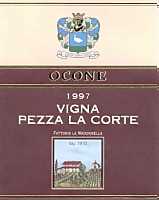
|
|
Aglianico del Taburno Vigna Pezza la Corte 1997 |
|
| Ocone (Italy) | |
| Grapes: Aglianico | |
| Price: € 11,00 | Score: |
| The wine shows a brilliant ruby red color and nuances of garnet red, moderate transparency. The nose reveals intense, clean, pleasing and elegant aromas which start with aromas of black cherry, plum and dried violet followed by good aromas of carob, blueberry, licorice and pleasing hints of vanilla and leather. In the mouth has good correspondence to the nose, a slightly tannic attack however well balanced by alcohol, good body and intense flavors. The finish is persistent with good flavors of plum and black cherry. A well made wine. This Aglianico ages for one year in steel tanks followed by about nine months in barrique. | |
| Food Match: Braised and stewed meat with mushrooms, Roasted meat, Hard cheese | |
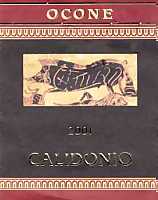
|
|
Taburno Piedirosso Calidonio 2001 |
|
| Ocone (Italy) | |
| Grapes: Piedirosso, Aglianico | |
| Price: € 15,00 | Score: |
| The wine shows an intense ruby red color and nuances of ruby red, moderate transparency. The nose denotes intense, clean, pleasing and elegant aromas which start with aromas of black cherry and blueberry followed by aromas of carob, cyclamen, licorice, blackberry, plum and dried violet. In the mouth has good correspondence to the nose, a slightly tannic attack however balanced by alcohol, good body and intense flavors. The finish is persistent with flavors of plum, black cherry and blueberry. Calidonio ages for 6 months in steel tanks and for 3 months in bottle. | |
| Food Match: Roasted meat, Stewed meat with mushrooms, Hard cheese | |
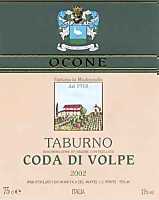
|
|
Taburno Coda di Volpe 2002 |
|
| Ocone (Italy) | |
| Grapes: Coda di Volpe | |
| Price: € 6,00 | Score: |
| The wine shows a brilliant greenish yellow color and nuances of greenish yellow, very transparent. The nose denotes intense, clean and pleasing aromas that start with aromas of hawthorn, pear and apple followed by aromas of lemon, hazelnut, peach and grapefruit. In the mouth has good correspondence to the nose, a crisp attack however balanced, agreeable and intense flavors. The finish is persistent with flavors of lemon, pear and peach. | |
| Food Match: Pasta and risotto with vegetables, Boiled fish, Aperitif | |
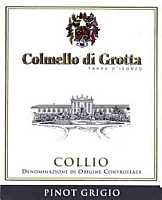
|
|
Collio Pinot Grigio 2002 |
|
| Colmello di Grotta (Italy) | |
| Grapes: Pinot Grigio | |
| Price: € 8,00 | Score: |
| The wine shows a pale straw yellow color and nuances of greenish yellow, very transparent. The nose reveals good personality with intense, clean, pleasing, elegant and refined aromas which start with hints of peach and elder followed by pleasing hints of hawthorn, chamomile, broom, litchi, apple, pear and pleasing hints of sage and tomato leaf. In the mouth has good correspondence to the nose, a crisp attack and however well balanced by alcohol, good body, intense flavors, agreeable. The finish is persistent with good flavors of peach, pear and apple. A well made wine. | |
| Food Match: Crustaceans, Roasted fish, Pasta and risotto with fish, Sauteed white meat | |
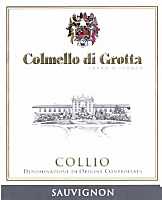
|
|
Collio Sauvignon 2002 |
|
| Colmello di Grotta (Italy) | |
| Grapes: Sauvignon Blanc | |
| Price: € 8,00 | Score: |
| The wine shows a pale straw yellow color and nuances of greenish yellow, very transparent. The nose reveals intense, clean, pleasing and elegant aromas which start with hints of elder, peach and pineapple followed by good aromas of banana, hawthorn, jasmine, litchi and pear. In the mouth has good correspondence to the nose, a crisp attack and however balanced by alcohol, good body, intense flavors, agreeable. The finish is persistent with flavors of peach, pineapple and pear. This Sauvignon Blanc ferments and ages in steel tanks. | |
| Food Match: Fried fish and crustaceans, Pasta and risotto with fish and crustaceans, Broiled fish | |
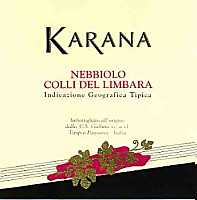
|
|
Karana 2001 |
|
| Cantina Sociale Gallura (Italy) | |
| Grapes: Nebbiolo (70%), Sangiovese (20%), Cabernet Sauvignon (10%) | |
| Price: € 5,00 | Score: |
| This wine shows an intense ruby red color and nuances of ruby red, moderate transparency. The nose reveals intense, clean and pleasing aromas that start with aromas of black cherry, violet and plum followed by aromas of blueberry and hints of licorice and cocoa. In the mouth has good correspondence to the nose, a slightly tannic attack however balanced, good body and intense flavors. The finish is persistent with flavors of black cherry, plum and blueberry. Karana ages for about 5-8 months. | |
| Food Match: Roasted and broiled meat, Hard cheese, Stuffed pasta | |
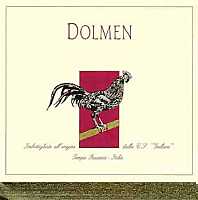
|
|
Dolmen 2000 |
|
| Cantina Sociale Gallura (Italy) | |
| Grapes: Nebbiolo (70%), Sangiovese (10%), Syrah (10%), Cabernet (10%) | |
| Price: € 15,00 | Score: |
| The wine shows an intense ruby red color and nuances of garnet red, little transparency. The nose reveals intense, clean, elegant and pleasing aromas which start with hints of black cherry, plum jam and toasted wood followed by good aromas of blueberry, blackberry, black currant, licorice, vanilla and a pleasing hint of cut grass. In the mouth has good correspondence to the nose, a slightly tannic and a slightly crisp attack however balanced, good body, intense flavors. The finish is persistent with flavors of plum jam, black cherry and blueberry. Dolmen ages for 15-20 months in barrique. | |
| Food Match: Roasted meat, Braised meat, Hard cheese | |
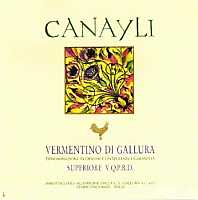
|
|
Vermentino di Gallura Superiore Canayli 2002 |
|
| Cantina Sociale Gallura (Italy) | |
| Grapes: Vermentino | |
| Price: € 7,00 | Score: |
| This wine shows a brilliant straw yellow color and nuances of straw yellow, very transparent. The nose reveals good personality and intense, clean, pleasing and elegant aromas which start with aromas of hawthorn, hazelnut and pear followed by good aromas of almond, pineapple, jasmine, apple, peach and hints of honey and green pepper. In the mouth has good correspondence to the nose, a crisp and slightly round attack however well balanced by alcohol, good body, intense flavors, agreeable. The finish is persistent with good flavors of peach, pear and almond. This Vermentino ages for 4-6 months. | |
| Food Match: Roasted fish, Roasted white meat, Pasta and risotto with fish, Soft cheese | |
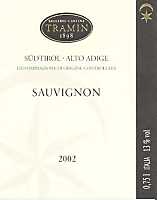
|
|
Alto Adige Sauvignon 2002 |
|
| Produttori Termeno (Italy) | |
| Grapes: Sauvignon Blanc | |
| Price: € 6,30 | Score: |
| The wine shows a pale straw yellow color and nuances of greenish yellow, very transparent. The nose denotes intense, clean, pleasing and elegant aromas that start with pleasing hints of peach and elder followed by good and intense aromas of acacia, pineapple, banana, litchi and pear. In the mouth has good correspondence to the nose, a crisp attack and however balanced by alcohol, good body, intense flavors, agreeable. The finish is persistent with flavors of peach, litchi and pineapple. This wine ferments in steel tanks. | |
| Food Match: Fried fish and crustaceans, Pasta and risotto with fish and crustaceans, Broiled fish | |

|
|
Alto Adige Pinot Nero Schiessstand 2000 |
|
| Produttori Termeno (Italy) | |
| Grapes: Pinot Nero | |
| Price: € 16,00 | Score: |
| The wine shows a brilliant ruby red color and nuances of garnet red, moderate transparency. The nose reveals good personality and intense, clean, pleasing, elegant and refined aromas which start with hints of cherry and raspberry followed by good aromas of strawberry jam, plum, dried rose as well as pleasing hints of licorice, cocoa and geranium. In the mouth has good correspondence to the nose, a slightly tannic attack and a pleasing crispness however well balanced by alcohol, good body, intense flavors, very agreeable. The finish is persistent with flavors of cherry, raspberry and strawberry. A well made wine. This Pinot Noir ages for 9 months in barrique followed by more aging in cask. | |
| Food Match: Roasted meat, Hard cheese, Stewed meat with mushrooms | |

|
|
Alto Adige Gewürztraminer Nussbaumer 2002 |
|
| Produttori Termeno (Italy) | |
| Grapes: Gewürztraminer | |
| Price: € 14,20 | Score: |
| The wine shows an intense straw yellow color and nuances of straw yellow, very transparent. The nose reveals personality with intense, clean, elegant, refined and pleasing aromas which start with a clean and typical aroma of grape, peach, honey and litchi followed by good and clean aromas of acacia, apricot, pineapple, orange, banana, passion fruit, lily, pear, white rose and sage. In the mouth has excellent correspondence to the nose, a crisp and pleasing round attack however well balanced by alcohol, good body, intense flavors, very agreeable. The finish is very persistent with long and clean flavors of peach, honey, litchi, banana and grape. A great wine. | |
| Food Match: Roasted and spiced fish, Roasted white meat, Hard cheese | |

|
|
Soave Classico Superiore Contrada Salvarenza Vecchie Vigne 2001 |
|
| Gini (Italy) | |
| Grapes: Garganega (90%), Chardonnay (10%) | |
| Price: € 17,00 | Score: |
| This wine shows a pale golden yellow color and nuances of golden yellow, very transparent. The nose reveals good personality with intense, clean, refined and pleasing aromas which start with aromas of hawthorn, honey and ripe apple followed by good aromas of pineapple, orange, broom, pear, peach and a pleasing hint of vanilla. In the mouth has good correspondence to the nose, a crisp and pleasing round attack however well balanced by alcohol, good body, intense, flavors, agreeable. The finish is persistent with flavors of apple, pear and peach. A well made wine. Salvarenza Vecchie Vigne ferments in barrique and ages for some months. | |
| Food Match: Pasta and risotto with mushrooms and meat, White meat, Roasted fish, Soft cheese | |
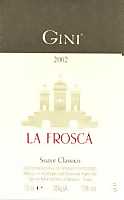
|
|
Soave Classico Superiore La Froscà 2002 |
|
| Gini (Italy) | |
| Grapes: Garganega (90%), Chardonnay (10%) | |
| Price: € 12,50 | Score: |
| This wine shows a pale straw yellow color and nuances of greenish yellow, very transparent. The nose reveals good personality with intense, clean, pleasing and elegant aromas which start with hints of acacia, peach and banana followed by pleasing and good aromas of broom, litchi, quince, pear and almond. In the mouth has good correspondence to the nose, a crisp and pleasing round attack however well balanced by alcohol, good body, intense flavors, agreeable. The finish is persistent with good flavors of banana, peach and pear. A well made wine. A small part of this wine ferments in barrique. | |
| Food Match: Pasta and risotto with vegetables, Soft cheese, Broiled and sauteed fish | |
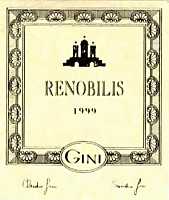
|
|
Recioto di Soave Renobilis 1999 |
|
| Gini (Italy) | |
| Grapes: Garganega (70%), Chardonnay (30%) | |
| Price: € 28,00 - 375ml | Score: |
| The wine shows an amber yellow color and nuances of amber yellow, very transparent. The nose reveals intense, clean, pleasing and intense aromas that start with hints of dried apricot, dried fig, hazelnut and honey followed by intense and good aromas of candied fruit, quince jam, peach jam, raisin, vanilla and a pleasing hint of enamel. In the mouth has good correspondence to the nose, a sweet and round attack however well balanced by alcohol, good sweetness, good body, agreeable. The finish is persistent with flavors of dried apricot, quince jam and honey. Renobilis ages for 3 years in cask. | |
| Food Match: Confectionery, Dessert with dried fruit and jams, Hard and piquant cheese | |
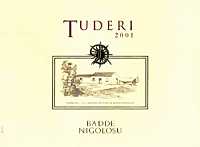
|
|
Tuderi 2001 |
|
| Tenute Dettori (Italy) | |
| Grapes: Cannonau | |
| Price: € 29,00 | Score: |
| The wine shows a brilliant ruby red color and nuances of ruby red, moderate transparency. The nose reveals intense, clean and pleasing aromas which start with hints of cherry and plum followed by good aromas of raspberry, carob, blackberry, dried violet, black cherry and hints of licorice. In the mouth has good correspondence to the nose, a slightly tannic attack and however balanced by alcohol, good body, intense flavors. The finish is persistent with good flavors of raspberry and black cherry. | |
| Food Match: Sauteed meat, Roasted meat, Hard cheese | |
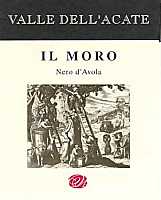
|
|
Il Moro 2001 |
|
| Valle dell'Acate (Italy) | |
| Grapes: Nero d'Avola | |
| Price: € 10,00 | Score: |
| The wine shows a brilliant ruby red color and nuances of ruby red, little transparency. The nose denotes intense, clean and pleasing aromas which start with hints of black cherry, blackberry and blueberry followed by good aromas of plum, violet and licorice. In the mouth has good correspondence to the nose, a slightly tannic attack and however balanced by alcohol, good body, intense flavors. The finish is persistent with flavors of black cherry and blueberry. This wine ages in steel tanks and in bottle for at least 9-12 months. | |
| Food Match: Broiled meat and barbecue, Sauteed meat with mushrooms, Stuffed pasta, Hard cheese | |
|
||||||||
|
DiWineTaste Polls
|
| |||||||
Privacy Policy | |||||||


| Copyright © 2002-2024 Antonello Biancalana, DiWineTaste - All rights reserved |
| All rights reserved under international copyright conventions. No part of this publication and of this WEB site may be
reproduced or utilized in any form or by any means, electronic or mechanical, without permission in writing from DiWineTaste. |